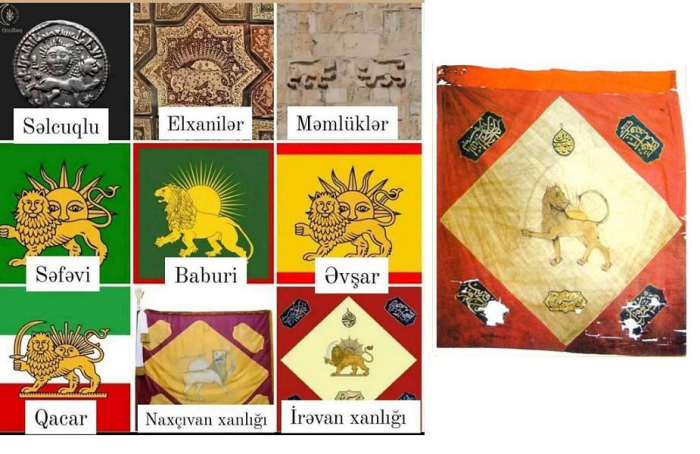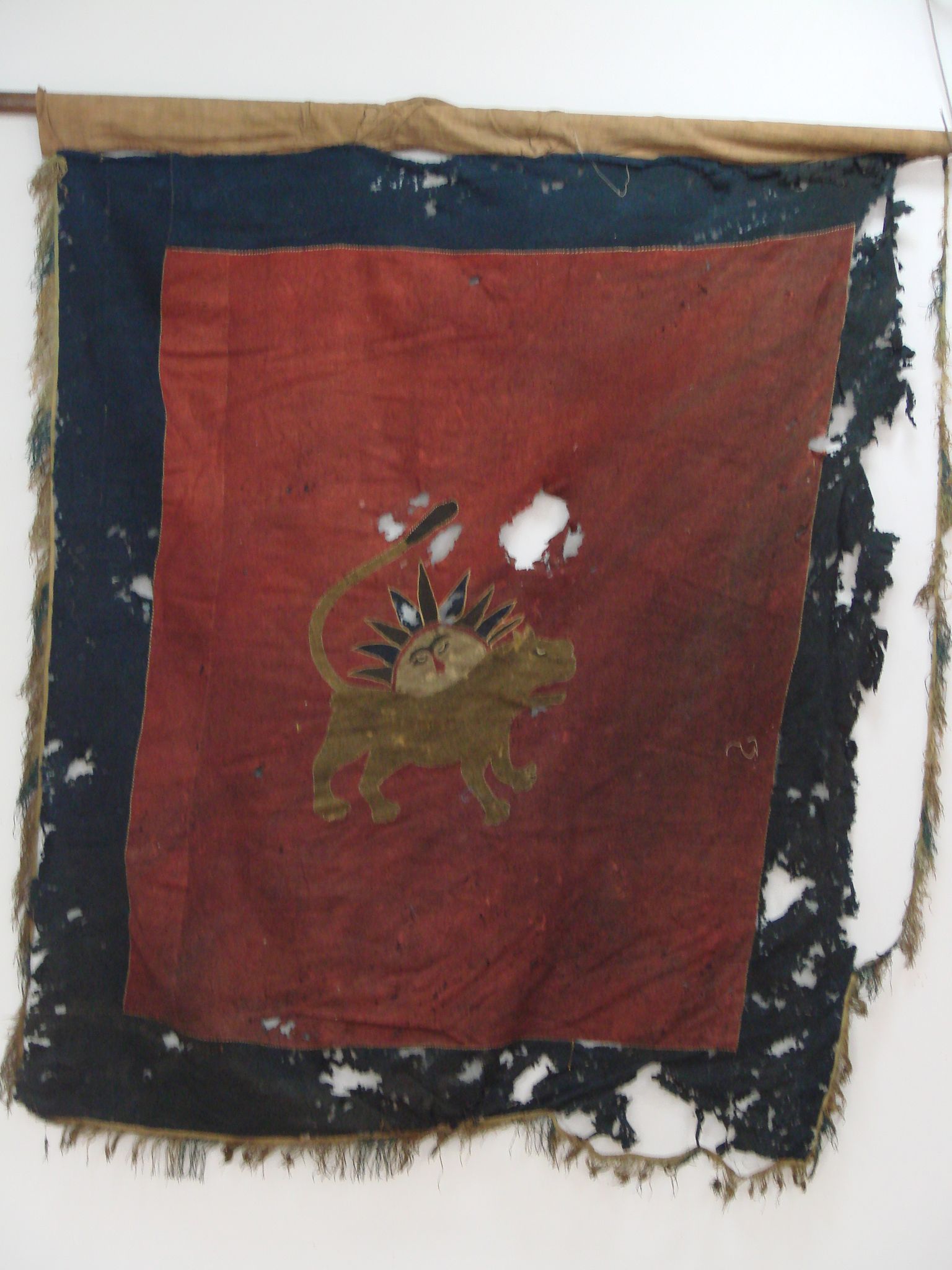05.05.23 22:20

"The times of power and glory came for Georgia under King Vakhtang the First, who reigned for fifty-three years - from 446 to 499. The Persians recognised him as Gurg-Aslan (the Wolf-Lion), because he was noted for his valiant courage and not without reason wore an image on his helmet of a wolf on the front and a lion on the back. Always going ahead of his soldiers, Vakhtang was personally known to his enemies, and on seeing his familiar helmet, his enemies usually shouted: "Beware! Gurg-Aslan!". This name remained with him in the Georgian history. - So wrote A.V.Potto in his work "The Caucasian War".
Gurg-Aslan (i.e. Wolf-Lion) as a nickname of King Vakhtang is found in all Georgian chronicles, later transformed into "Gorgasali". However, in Soviet times, the "deciphering" of the name of King Vakhtang Gorgasali changed for some reason. In all Soviet textbooks and historical works his name is deciphered as "translation from Persian" "wolf's head", although in reality neither Gorgasali, nor Gurg-Aslan has anything in common with this translation except for the part "gurg", i.e. wolf. If literal translation "wolf's head" in Persian, it would sound like "gurgsar". But that was not the name of tsar Vakhtang anywhere, and such name is not present in any Georgian chronicles. That is, for some reason Soviet ideologists began diligently to erase mentioning of a lion - Aslan or "Arslan" in Georgian history and in the name of the outstanding Georgian king (founder of Tbilisi). Even allowing outright falsifications.
That it was a "global" order against the Turkic symbol of the "Lion and Sun" is evidenced by the fact that Turkic symbols and even references to Turkic words were fought against in the Soviet Union, and in Iran, and beyond. In particular, in Georgia, where under Soviet rule it was considered "not shameful" to point out the alleged "Persian" origin of the names of Georgian kings in antiquity. But they tried not to mention the fact that in reality they were related to Turks (the Khusroids dynasty, to which Vakhtang Gorgasali belonged, was of Parthian, i.e. "Turan" or Turkic origin). And they tried to "delete" even a part of Vakhtang's name - "Aslan" or "Lev" because Aslan is a Turkic word. And Soviet and European historiography argued that the Turks are supposedly 'wild nomads' who appeared in the Caucasus 'only in the 11th century'. And if you listen to Armenian nationalists, the Azerbaijani Turks "settled in native Armenian lands" only in the 19th and 20th centuries.
However, Soviet historiographers were not alone here. Unexpectedly, at the same time, the "struggle against the Lion" began in Iran under the Pahlavi dynasty, which replaced the Qajar Turkish dynasty in 1925 with the help of the British. The Pahlavis embarked on a course of Iranian nationalism. Everything Turkic, including Turkic symbols, was purged from the country's history. The traditional symbol of Iran's former dynasties - the Lion and the Sun - was also erased. The campaign to abolish the emblem was initiated in Iran by one of the followers of pan-Iranianism, Mojtaba Minuvi, in 1929. In a report prepared at the request of the Iranian embassy in London, Mojtaba Minuvi pointed out that the lion and sun symbol was Turkic in origin. His recommendation to the government was to replace it with another national logo, "Darvash Qawini":
"We cannot relate national historical lore to the Lion and Sun emblem as it has no relation to pre-Islamic history, there is no evidence that Iranians designed or created it... We can also get rid of this relic of the Turkic people and adopt a flag that best symbolises our legendary greatness, the Darvash Qawini".
However, the standard "Darvash Qawini" (a circle and four "petals" in the corners) never caught on in Iran. Over time, the Pahlavi dynasty, contrary to historical truth, declared the "Lion and Sun" symbol to be "native Iranian", although actually for the first time in the history of Iran the symbol of the Lion and the Sun is found on the coins of the Seljukid Turkic dynasty. The Seljukid Empire reached the height of its power under Sultan Alp Arslan, whose name is translated from Turkic as "The Brave Lion". That is, the symbol of the Lion, Aslan or Arslan was originally an ancient Turkic symbol. Proof of that is also the fact that it was widespread very far from Iran. In particular the lion (though without the sun) is depicted on the coat of arms of Bulgaria. It, too, is of Old Turkic origin. Although, for the first time as the emblem of the Bulgarian kings it is mentioned in the 13th century reigning in the Bulgarian kingdom Turkic by origin Aseni (Ancient Turkic race Asina), but apparently, the lion was a symbol of the Bulgarians before. Incidentally, the Türkic roots of the Bulgarians were suppressed for a long time (emphasis was placed on their "Slavicness").
Reference is made to a lion as a symbol in the ancient sources in relation to the Karluks, a Turkic people who founded the Karluks Kaganate in the territory of Central Asia and became one of the successors of the disintegrated Turkic Kaganate. The first Chinese mention of Karluks, dated 644, is connected just with a symbol of a lion - "Lev Karluks ("Shi-Gelolu" where "shi" means "lion" in Sogdian), or Arslan Karluks. The name Arslan (i.e. Lev) itself became widespread among Turkic rulers of Central Asia - the same Karaluk khans and khans.
Upon creation of the Chinggisid Empire (in which the main role belonged to Turks) the Lion and Sun symbol also became a state symbol; with its collapse it was used in the Ilkhan State which included the whole of the current Iran. Outside the Chingizid Empire the Turkic symbol of the Lion and the Sun also caught on, in particular in the Mamluk State established by the Kipchak Turks in Egypt, Palestine and Syria. With the emergence of the Timurid Empire it also adopted the symbol of the "Lion and the Sun". Later on, this symbol was used by the conqueror of India, the descendant of the Timurids Babur (who founded the Mughal Empire) and the Baburids who ruled that empire.
The Lion and Sun symbol became particularly popular during the rule of the Safavid dynasty of Turks in Azerbaijan. During the Safavid era, it denoted two pillars of society: the state and the Islamic religion. The significance of this symbol was preserved during the Ashfara and Qajar dynasties. Also, the "Lion and Sun" symbol was adopted as a state symbol by the Iravan and Nakhichevan Azerbaijani khanates, which were formed after the Ashfara empire.
In general, if you add up how many years the Turks have ruled modern Iran, it is difficult to understand why it is considered a "Persian state" by "Great Iranian" nationalists:
Ghaznavids 231 years
Seljuks 165 years
Khorezmians 221 years
Ilkhanids 90 years
Timurids 136 years
Jelaiyrs 97 years
Chobanids 22 years
Ak Koyunlu 130 years
Kara Koyunlu 91 years
Safavids 231 years
Afshars 60 years
Qajars 140 years
I.e. in total 1614 years Turks ruled Iran uninterruptedly. Only thanks to Turks today the statehood in territory of Iran was kept and in general modern Iran exists. Only during the last 80 years non Turks ruled Iran. Even the Islamic Revolution of 1979 which was supported by Iran's Turkic population has not changed the struggle of the authorities in Tehran with everything Turkic. True, the ban on the Azerbaijani language introduced under the Pahlavi was lifted (but it is still restricted everywhere), but the "Lion and Sun" symbol was banned altogether. This time as a "symbol of the Shah's regime".

The Janashia National Museum of Georgia - the flag of the Karabakh Khanate
Varden Tsulukidze
Read: 901
Write comment
(In their comments, readers should avoid expressing religious, racial and national discrimination, not use offensive and derogatory expressions, as well as appeals that are contrary to the law)
News feed
-
18:0019.04.24
-
The state property the government sold this year at the lowest price
17:3019.04.24
-
17:0019.04.24
-
16:1919.04.24
-
Vakhtang Gomelauri: An attack on a policeman means an attack on a state institution
15:4119.04.24
-
15:0019.04.24
-
14:1519.04.24
-
What are the dangers of France's interference in Ukraine and the South Caucasus?
13:3719.04.24
-
The Prime Minister met the Ambassador of Iran in Georgia
12:5719.04.24
-
12:1519.04.24
-
Georgian FM meets U.S. Senior Advisor for Caucasus Negotiations
11:2919.04.24
-
Foreign Ministry denies reports about summoning of Georgian Ambassador to Bundestag
10:0019.04.24
-
Parliament to hear Ministers of Interior and Economy on April 19
18:0018.04.24
-
Competition Agency: 23,983 concentrations of economic entities registered in Q1
17:2518.04.24
-
Georgian PM, EUMM Head review situation in Russian-occupied territories
16:4518.04.24
-
UK Ambassador on transparency bill: hindrances to civil society’s functioning “concerning”
16:1018.04.24
-
15:4018.04.24
-
15:3018.04.24
-
14:4218.04.24
-
13:4118.04.24
-
12:4518.04.24
-
11:0018.04.24
-
10:1118.04.24
-
PM: NGOs never decried calls for second front
18:1117.04.24
-
Ruling party official: future of Georgia belongs to Europe
17:0917.04.24
-
16:1317.04.24
-
15:3117.04.24
-
Parliament adopts bill on Transparency of Foreign Influence with first reading
14:5717.04.24
-
GD MP says foreigners should not call for Rose Revolution in Georgia
13:4717.04.24
-
12:4117.04.24
-
Four police officers got injuries during anti-Transparency Bill protest
11:5417.04.24
-
Russia rushes Iran with Resht-Astara railway line
23:4516.04.24
-
18:0016.04.24
-
17:2516.04.24
-
Communications Commission: EU experts say Georgian mobile market “non-competitive”
16:4316.04.24
-
Georgian Foreign Minister, Chinese delegation discuss bilateral relations
16:0016.04.24


